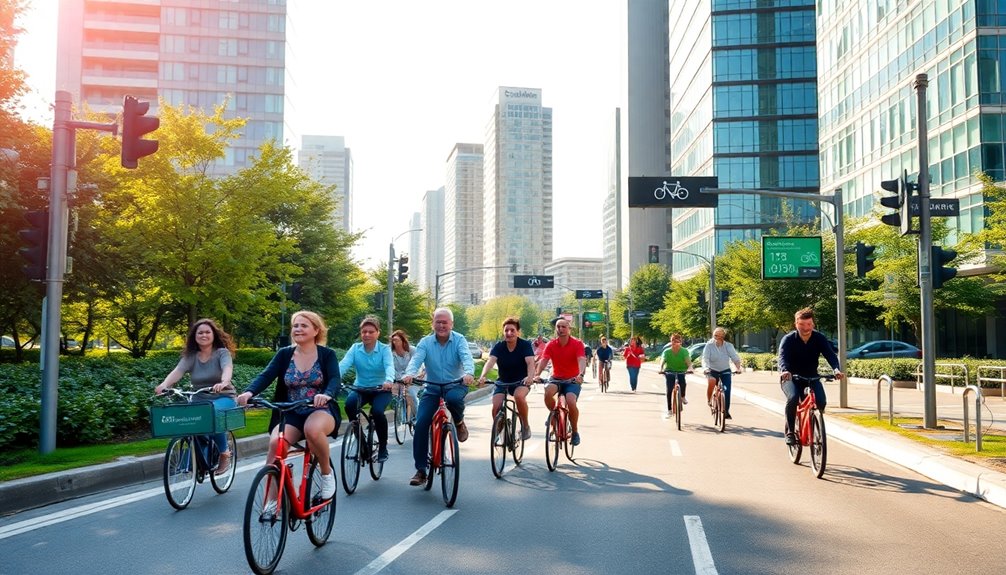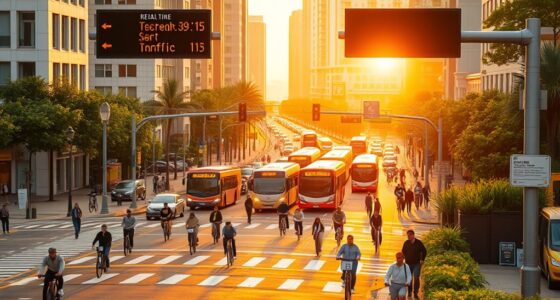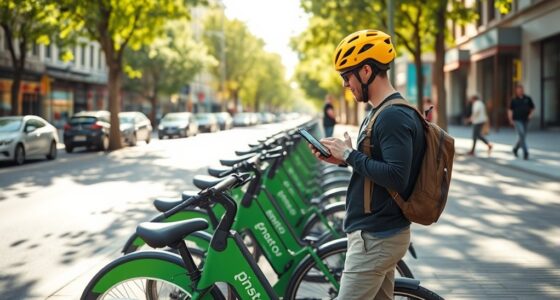Cities are becoming more bike-friendly by expanding protected cycle lanes and implementing policies that enhance safety. They're using data-driven planning to optimize bike networks and engaging communities through workshops and events. These efforts create economic benefits while reducing pollution. As cities prioritize cycling infrastructure, they're fostering a vibrant cycling culture that promotes health and sustainability. If you want to discover how these innovative solutions continue to shape urban landscapes, there's more to explore.
Key Takeaways
- Cities are expanding protected cycle lanes, enhancing safety and navigation for cyclists, as seen in Bogotá and Bremen.
- Policy changes, like California's A.B. 1909, support cyclist safety by allowing them to cross streets with pedestrians.
- Data-driven planning using tools like OpenStreetMap and OSMnx helps optimize bike network connectivity and infrastructure efficiency.
- Community engagement through workshops, rides, and ambassador programs fosters local support for cycling initiatives and enhances culture.
- Investing in cycling infrastructure generates more jobs and reduces pollution, contributing to economic growth and environmental sustainability.
Infrastructure Improvements for Cyclists

As cities strive to become more bike-friendly, infrastructure improvements for cyclists play a crucial role in enhancing safety and accessibility.
You'll notice that cities like Bogotá lead the way with over 540 kilometers of protected cycle lanes, while Glasgow sets ambitious targets to expand its network.
Santiago's commitment to 1,000 kilometers of bike lanes shows a strong dedication, despite uneven distribution. Bremen's 821 kilometers create a seamless cycling experience.
Protected bike lanes are vital for your safety, especially on busy roads. Connected networks and efficient grid designs help you navigate easily, reducing interaction with traffic.
Protected bike lanes enhance safety on busy roads, while connected networks simplify navigation and minimize traffic interaction.
With innovations like bike parking facilities and clear signage, these improvements make cycling a more appealing and secure option for your daily commute.
Policy Changes Supporting Bike Safety

While cities around the world adopt various strategies to enhance bike safety, effective policy changes are essential for creating a safer environment for cyclists.
Legislative changes, like California's A.B. 1909, let you cross streets with pedestrians, improving safety. Federal regulations are pushing for vulnerable road users' prioritization in the Highway Safety Improvement Program.
Local ordinances, such as reduced speed limits in Flower Mound, Texas, further protect cyclists. Law enforcement's targeted operations and public awareness campaigns help ensure compliance with traffic laws.
Advocacy groups like PeopleForBikes work tirelessly to influence policies, while community engagement fosters support for bike-friendly initiatives.
These comprehensive policy shifts are vital for enhancing your cycling experience and safety on the road.
Data-Driven Planning for Better Bike Networks

To create better bike networks, cities increasingly rely on data-driven planning that utilizes innovative tools and algorithms. By leveraging OpenStreetMap (OSM), you gain access to comprehensive street and bicycle infrastructure data, covering over 80% of the world.
The OSMnx library helps construct detailed urban graphs, representing intersections and bike paths. Algorithms like the Largest-to-Closest (L2C) significantly improve network connectedness, as seen in Budapest and Bogota, where minimal investments yielded substantial results.
You can measure effectiveness using metrics like the fraction of nodes in the largest connected component. As cities evolve, integrating traffic data and optimizing directness will enhance future bike infrastructure, ensuring safer, more efficient routes for cyclists.
Engaging Communities in Cycling Initiatives

Data-driven planning lays the foundation for effective bike networks, but engaging communities is just as important for successful cycling initiatives.
Public workshops in cities like New York City and Austin invite you to share your thoughts on bike share planning. Community rides help you gain experience and build support, while Open Streets events create car-free spaces for you to enjoy cycling with others.
Ambassador programs employ local residents to promote these initiatives, ensuring diverse involvement through inclusive imagery. Collaborating with local groups and businesses further strengthens community ties.
Monthly rides and cycling festivals foster a vibrant cycling culture, while education and incentives encourage more people to embrace biking. Engaging communities truly makes cycling accessible and enjoyable for everyone.
Economic and Environmental Benefits of Cycling

Cycling offers a wealth of economic and environmental benefits that can transform urban landscapes. By investing in cycling infrastructure, cities create more jobs per dollar than traditional road projects. This investment not only saves on healthcare costs related to traffic accidents but also boosts retail activity and property values.
Bicycle tourism brings additional revenue, attracting visitors eager to explore local businesses. Environmentally, cycling reduces pollution and lowers carbon emissions, contributing to a cleaner atmosphere. Bike lanes promote sustainable transport, enhancing urban biodiversity and green spaces. Additionally, cities that embrace cycling can also help foster high vibrational energy, promoting overall community well-being and healthier lifestyles.
Ultimately, cycling is a low-cost, high-impact solution for healthier, more vibrant cities, making it an essential component of modern urban planning.
Innovative Solutions Enhancing Bike Accessibility

As cities strive to become more bike-friendly, innovative solutions are key to enhancing bike accessibility for everyone.
Smart bike parking stations, like those from Bikeep, offer secure storage with alarms and real-time data management, making cycling safer. E-bike charging stations encourage sustainable transportation, while co-branded bike racks foster community pride.
Protected bike lanes and connected networks improve safety and accessibility, significantly increasing bike usage.
Artistic and functional bike racks not only beautify cities but also secure bicycles efficiently. Advanced infrastructure, such as elevated paths and solar-powered lanes, showcases high-tech solutions.
Frequently Asked Questions
How Can I Report Unsafe Bike Lanes in My City?
To report unsafe bike lanes in your city, start by identifying the specific issue, whether it's a pothole or poor visibility.
Use online reporting tools or mobile apps if available. You can also contact your local government via phone or email.
Be sure to provide location details, a clear description, and any photos. Sharing your name and contact information will help authorities follow up on your report.
Your input can make a difference!
Are There Any Grants Available for Community Bike Projects?
Yes, there are several grants available for community bike projects.
You can apply for Community Spark Grants from the League of American Bicyclists or consider the Jeff Roth Cycling Foundation Grants, which promote safe cycling.
Local governments often provide funding tied to community initiatives, and private foundations may also support bike projects.
Make sure your project involves community engagement, has clear goals, and meets any specific application requirements to increase your chances of success.
How Do I Get Involved in Local Cycling Advocacy?
To get involved in local cycling advocacy, start by connecting with local bicycle coalitions and community groups.
Attend meetings and engage with members to understand their initiatives.
Reach out to local government officials to voice your support for bike-friendly policies.
You can also participate in community events and educational programs to raise awareness.
Joining citizen-led committees will help prioritize projects that enhance cycling infrastructure, making your community safer and more accessible for cyclists.
What Are the Health Benefits of Cycling Regularly?
Cycling regularly offers numerous health benefits that you'll appreciate. It strengthens your heart, boosts cardiovascular fitness, and can lower your risk of heart disease significantly.
You'll also find that cycling helps in cancer prevention, reducing the risk of colon and breast cancers.
Not only does it enhance your mental well-being by lowering stress and anxiety, but it's also a great way to improve joint mobility and overall physical fitness.
How Can I Find Bike-Friendly Accommodations While Traveling?
To find bike-friendly accommodations while traveling, check directories like Bikabout, look for hotels with complimentary bikes, and search for places near bike trails or bike-share stations.
Consider amenities like secure bike storage, tools, and maps. Seek out hotels that engage with local cycling communities to get insights on routes.
Lastly, explore options that offer bike tourism packages, ensuring an enjoyable and convenient cycling experience during your trip.
Conclusion
As cities pedal towards a greener future, your role in this transformation is vital. By embracing bike-friendly infrastructure and supporting policies, you're not just riding a wave of change; you're steering it. Picture the streets alive with cyclists, each turn of the wheel echoing the beat of a healthier community. Together, we can weave a tapestry of vibrant neighborhoods, where the hum of bike tires replaces the roar of engines, creating a symphony of sustainability.









